Experimental Investigation on the Deformability, Ultrasonic Wave Propagation, and Acoustic Emission of Rock Salt Under Triaxial Compression
Abstract
1. Introduction
2. Experimental Program
2.1. Experimental Apparatus
2.2. Test Specimens
2.3. Test Procedures
3. Experimental Results
3.1. Deformation Characteristics
3.2. Ultrasonic Wave Analysis
3.3. AE Activity
4. Discussions
5. Conclusions
Author Contributions
Acknowledgments
Conflicts of Interest
References
- Bérest, P.; Bergues, J.; Brouard, B.; Durup, J.G.; Guerber, B. A salt cavern abandonment test. Int. J. Rock. Mech. Min. 2001, 38, 357–368. [Google Scholar] [CrossRef]
- Ma, H.L.; Yang, C.H.; Li, Y.P.; Shi, X.L.; Liu, J.F.; Wang, T.T. Stability evaluation of the underground gas storage in rock salts based on new partitions of the surrounding rock. Environ. Earth Sci. 2015, 73, 6911–6925. [Google Scholar] [CrossRef]
- Schulze, O.; Popp, T.; Kern, H. Development of damage and permeability in deforming rock salt. Eng. Geol. 2001, 61, 163–180. [Google Scholar] [CrossRef]
- Yang, C.H.; Daemen, J.J.K.; Yin, J.H. Experimental investigation of creep behavior of salt rock. Int. J. Rock Mech. Min. 1999, 36, 233–242. [Google Scholar] [CrossRef]
- Bérest, P.; Brouard, B. Safety of salt caverns used for underground storage—Blow out; Mechanical instability; Seepage; Cavern abandonment. Oil. Gas. Sci. Technol. 2003, 58, 361–384. [Google Scholar] [CrossRef]
- Neal, J.T.; Magorian, T.R. Geologic site characterization (GSC) principles derived from storage and mining projects in salt, with application to environmental surety. Environ. Geol. 1997, 29, 165–175. [Google Scholar] [CrossRef]
- Sovacool, B.K. The costs of failure: A preliminary assessment of major energy accidents, 1907–2007. Energy Policy 2008, 36, 1802–1820. [Google Scholar] [CrossRef]
- Yang, C.H.; Jing, W.J.; Daemen, J.J.K.; Zhang, G.M.; Du, C. Analysis of major risks associated with hydrocarbon storage caverns in bedded salt rock. Reliab. Eng. Syst. Saf. 2013, 113, 94–111. [Google Scholar] [CrossRef]
- Lu, X.B.; Wu, J.Y. Theory and Application of Impact Elastic Wave; China Water and Power Press: Beijing, China, 2016; pp. 6–7. ISBN 978-7-5170-4481-9. [Google Scholar]
- Oconnell, R.J.; Budiansky, B. Seismic veloctities in dry and saturated cracked solid. J. Geophys. Res. 1974, 79, 5412–5425. [Google Scholar] [CrossRef]
- Budiansky, B.; Oconnell, R.J. Elastic moduli of a cracked solid. Int. J. Solids Struct. 1976, 12, 81–97. [Google Scholar] [CrossRef]
- Bellanger, M.; Remy, J.M.; Homand, F. Ultrasonic wave attenuation as a tool for estimating frost action on limestone rocks. Mater. Struct. 1996, 29, 552–561. [Google Scholar] [CrossRef]
- Falls, S.D.; Young, R.P. Acoustic emission and ultrasonic-velocity methods used to characterise the excavation disturbance associated with deep tunnels in hard rock. Tectonophysics 1998, 289, 1–15. [Google Scholar] [CrossRef]
- Ai, H.R.A.; Ahrens, T.J. Effects of shock-induced cracks on the ultrasonic velocity and attenuation in granite. J. Geophys. Res. 2007, 112, b01201. [Google Scholar] [CrossRef]
- Chaki, S.; Takarli, M.; Agbodjan, W.P. Influence of thermal damage on physical properties of a granite rock: Porosity, permeability and ultrasonic wave evolutions. Constr. Build. Mater. 2008, 22, 1456–1461. [Google Scholar] [CrossRef]
- Vasconcelos, G.; Lourenco, P.B.; Alves, C.A.S.; Pamplona, J. Ultrasonic evaluation of the physical and mechanical properties of granites. Ultrason 2008, 48, 453–466. [Google Scholar] [CrossRef] [PubMed]
- Wang, Y.; Li, C.H. Investigation of the P- and S-wave velocity anisotropy of a Longmaxi formation shale by real-time ultrasonic and mechanical experiments under uniaxial deformation. J. Petrol. Sci. Eng. 2017, 158, 253–267. [Google Scholar] [CrossRef]
- Li, H.R.; Dong, Z.K.; Yang, Y.; Liu, B.; Chen, M.Y.; Jing, W.J. Experimental study of damage development in salt rock under uniaxial stress using ultrasonic velocity and acoustic emissions. Appl. Sci. 2018, 8. [Google Scholar] [CrossRef]
- Chen, J.; Kang, Y.F.; Liu, W.; Fan, J.Y.; Jiang, D.Y.; Chemenda, A. Self-healing capacity of damaged rock salt with different initial damage. Geomech. Eng. 2018, 15, 615–620. [Google Scholar] [CrossRef]
- Chen, J.; Ren, S.; Yang, C.H.; Jiang, D.Y.; Li, L. Self-healing characteristics of damaged rock salt under different healing conditions. Materials 2013, 6, 3438–3450. [Google Scholar] [CrossRef]
- Mogi, K. Study of elastic shocks caused by the fracture of heterogeneous materials and its relation to earthquake phenomena. Bull. Earthq. Res. Inst. 1962, 40, 125–173. [Google Scholar]
- Rao, M.; Ramana, Y.V. A study of progressive failure of rock under cyclic loading by ultrasonic and ae monitoring techniques. Rock Mech. Rock Eng. 1992, 25, 237–251. [Google Scholar] [CrossRef]
- Filimonov, Y.L.; Lavrov, A.V.; Shafarenko, Y.M.; Shkuratnik, V.L. Memory effects in rock salt under triaxial stress state and their use for stress measurement in a rock mass. Rock Mech. Rock Eng. 2001, 34, 275–291. [Google Scholar] [CrossRef]
- Rodríguez, P.; Arab, P.B.; Celestino, T.B. Characterization of rock cracking patterns in diametral compression tests by acoustic emission and petrographic analysis. Int. J. Rock Mech. Min. 2016, 83, 73–85. [Google Scholar] [CrossRef]
- Chen, G.Q.; Guo, F.; Wang, J.C.; Zhou, Y.X. Experimental study of creep properties of quartz sandstone after freezing-thawing cycles. Rock Soil Mech. 2017, 38, 203–210. [Google Scholar] [CrossRef]
- Ge, Z.L.; Sun, Q. Acoustic emission (AE) characteristics of granite after heating and cooling cycles. Eng. Fract. Mech. 2018, 200, 418–429. [Google Scholar] [CrossRef]
- Ren, S.; Bai, Y.M.; Jiang, D.Y.; Yang, C.H.; Chen, J. Experimental research on acoustic emission property of salt rock under cyclic loading. Rock Soil Mech. 2012, 33, 1613–1618. [Google Scholar] [CrossRef]
- Ren, S.; Bai, Y.M.; Zhang, J.P.; Jiang, D.Y.; Yang, C.H. Experimental investigation of the fatigue properties of salt rock. Int. J. Rock Mech. Min. 2013, 64, 68–72. [Google Scholar] [CrossRef]
- Alkan, H.; Cinar, Y.; Pusch, G. Rock salt dilatancy boundary from combined acoustic emission and triaxial compression tests. Int. J. Rock. Mech. Min. 2007, 44, 108–119. [Google Scholar] [CrossRef]
- Yang, Y.J.; Wang, D.C.; Guo, M.F.; Li, B. Study of rock damage characteristics based on acoustic emission tests under triaxial compression. Chin. J. Rock Mech. Eng. 2014, 33, 98–104. [Google Scholar] [CrossRef]
- Li, Y.; Zhang, K.; Wu, X.W. Study of ultrasonic wave characteristics of shale in triaxial compression tests. J. Geophys. Eng. 2018, 15, 2183–2193. [Google Scholar] [CrossRef]
- Jia, S.P.; Luo, J.Z.; Yang, J.P.; Gao, M.; Gong, J. An elastoplastic damage constitutive model for salt rock considering confining pressure effect. Rock Soil Mech. 2015, 36, 1549–1556. [Google Scholar] [CrossRef]
- Wang, B.; Zhu, J.B.; Yan, P.; Huang, S.L.; Wu, A.Q. Damage Strength Determination of Marble and its Parameters Evaluation based on Damage Control Test. Chin. J. Rock Mech. Eng. 2012, 31, 3967–3973. [Google Scholar]
- Liu, J.F.; Bian, Y.; Zheng, D.W.; Wu, Z.D.; Li, T.Y. Discussion on strength analysis of salt rock under triaxial compressive stress. Rock Soil Mech. 2014, 35, 919–925. [Google Scholar] [CrossRef]
- Guo, Y.T.; Yang, C.H.; Fu, J.J. Experimental research on mechanical characteristics of salt rock under triaxial unloading test. Rock Soil Mech. 2012, 33, 725–732. [Google Scholar] [CrossRef]
- Geiger, L. Probability method for the determination of earthquake epicenters from the arrival time only. Bull. St. Louis Univ. 1912, 8, 56–71. [Google Scholar]
- Ai, T.; Zhang, R.; Liu, J.F.; Zhao, X.P.; Ren, L. Space-time evolution rules of acoustic emission locations under triaxial compression. J. China Coal Soc. 2011, 36, 2048–2057. [Google Scholar] [CrossRef]
- Fang, Y.R.; Geng, N.G.; Zhang, Z.; Wu, K.T. Relative quiet of acoustic emissions anterior rock rupture. Earthq. Res. Sichuan 1988, 3, 5–8. [Google Scholar]
- Yin, X.G.; Li, S.L.; Tang, H.Y.; Pei, J.L. Study on quiet period and its fractal characteristics of rock failure acoustic emission. Chin. J. Rock Mech. Eng. 2009, 28 (Suppl. 2), 3383–3390. [Google Scholar]
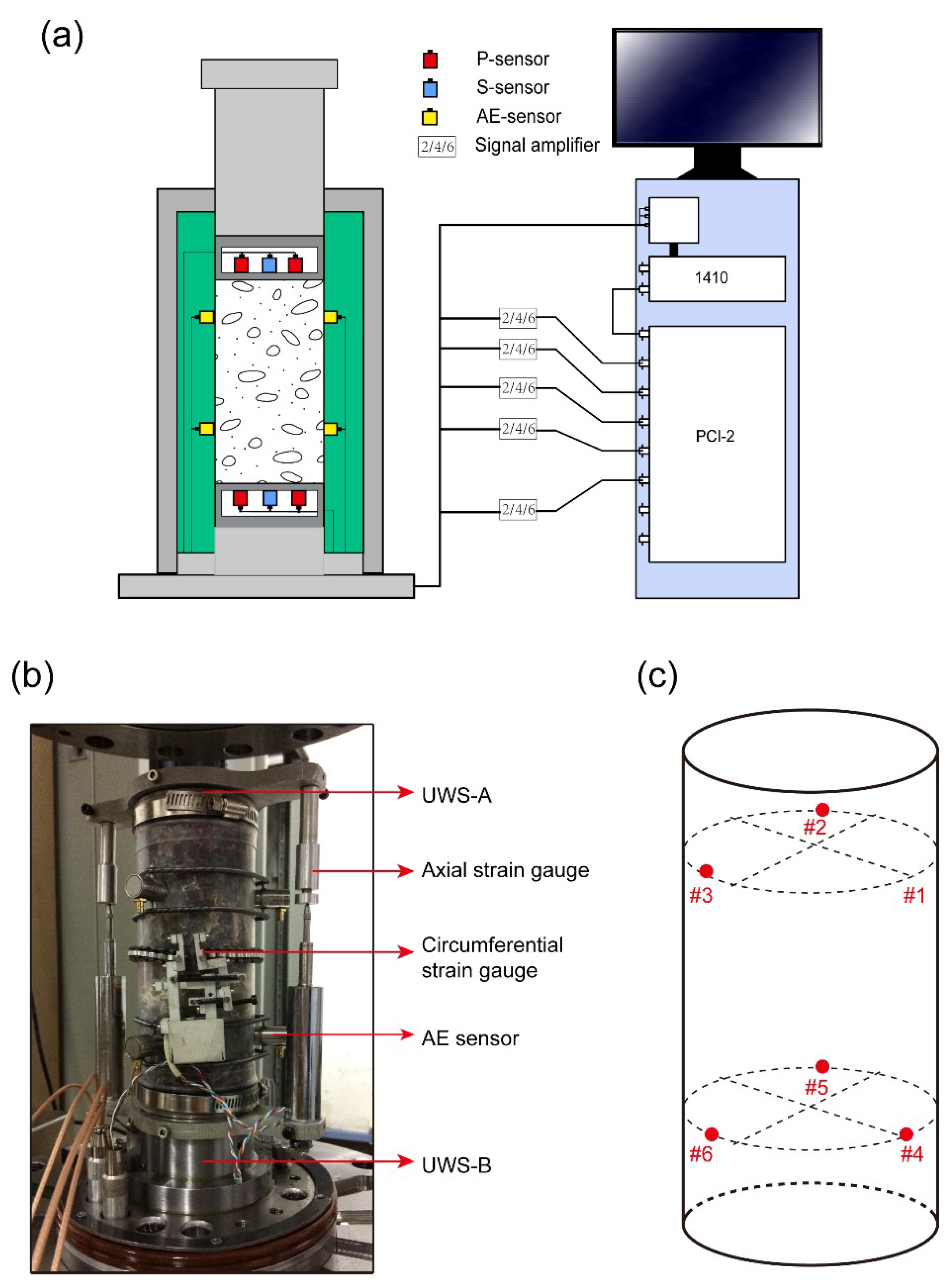

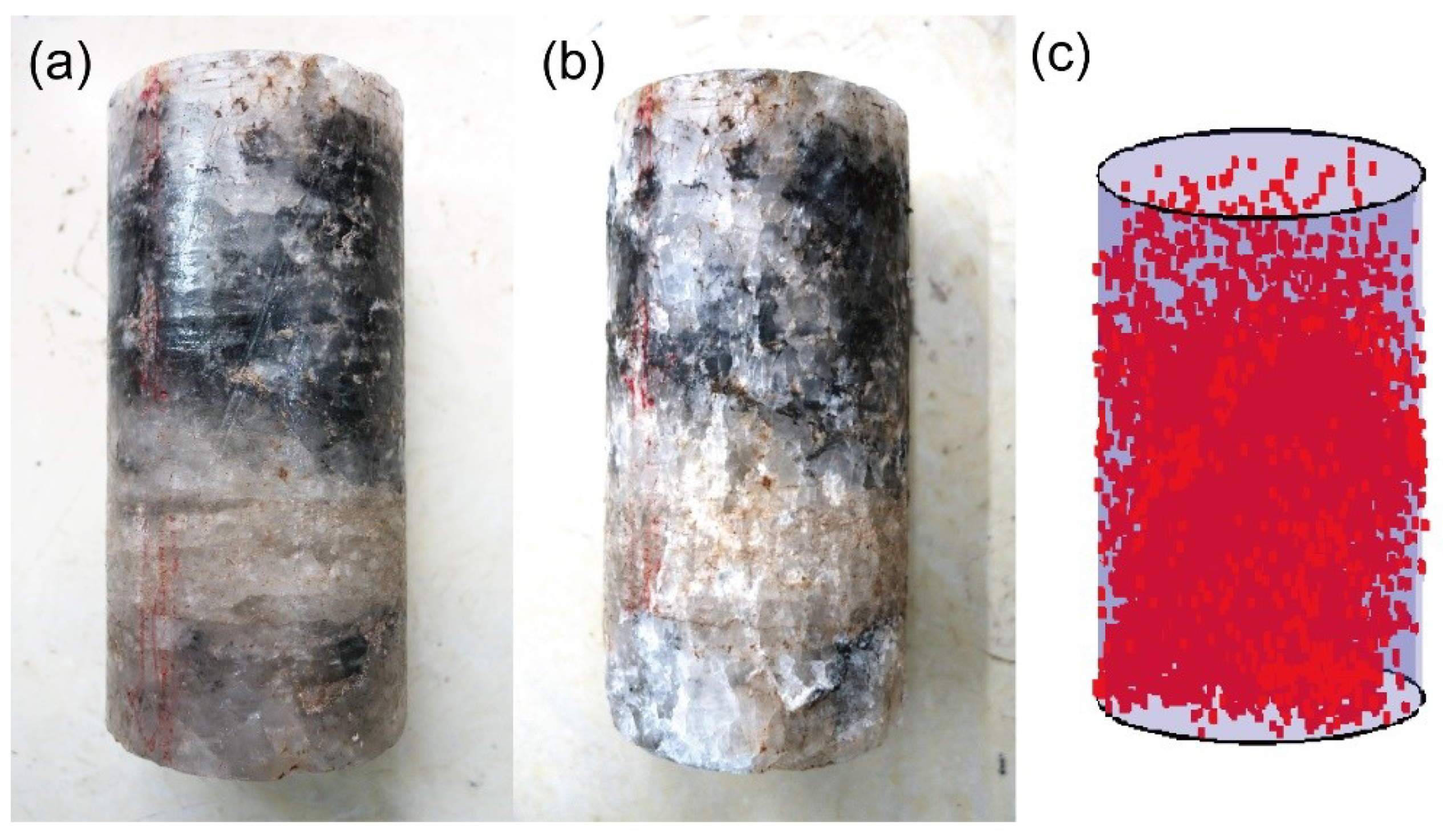
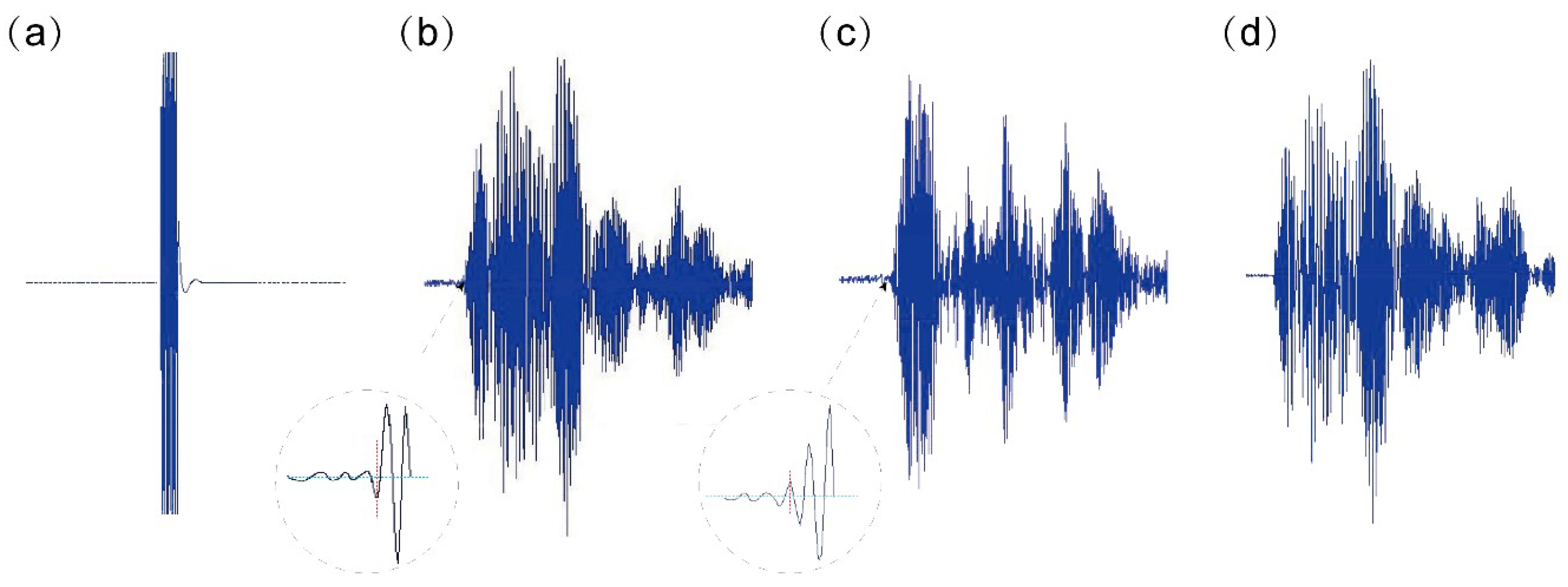
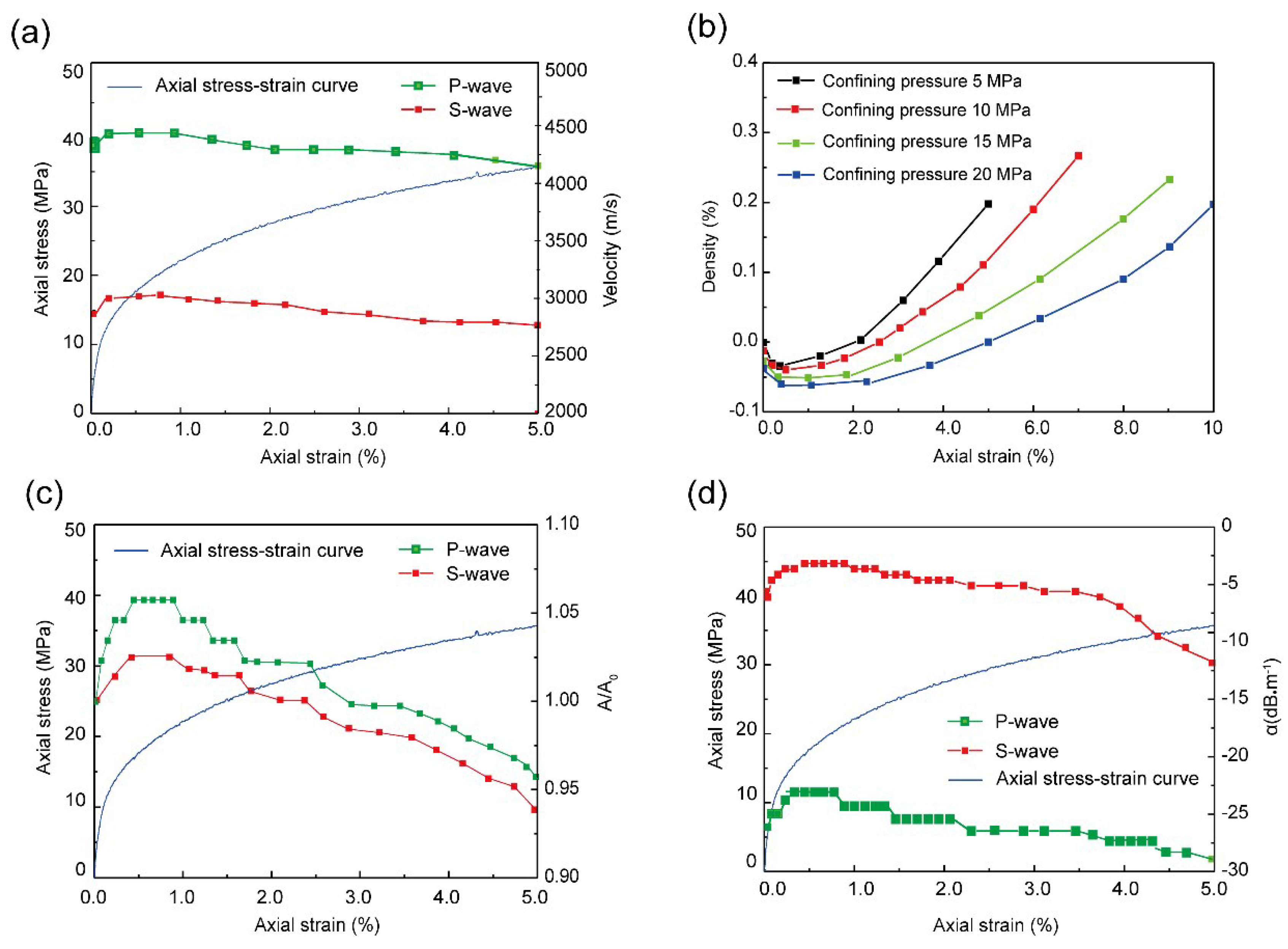
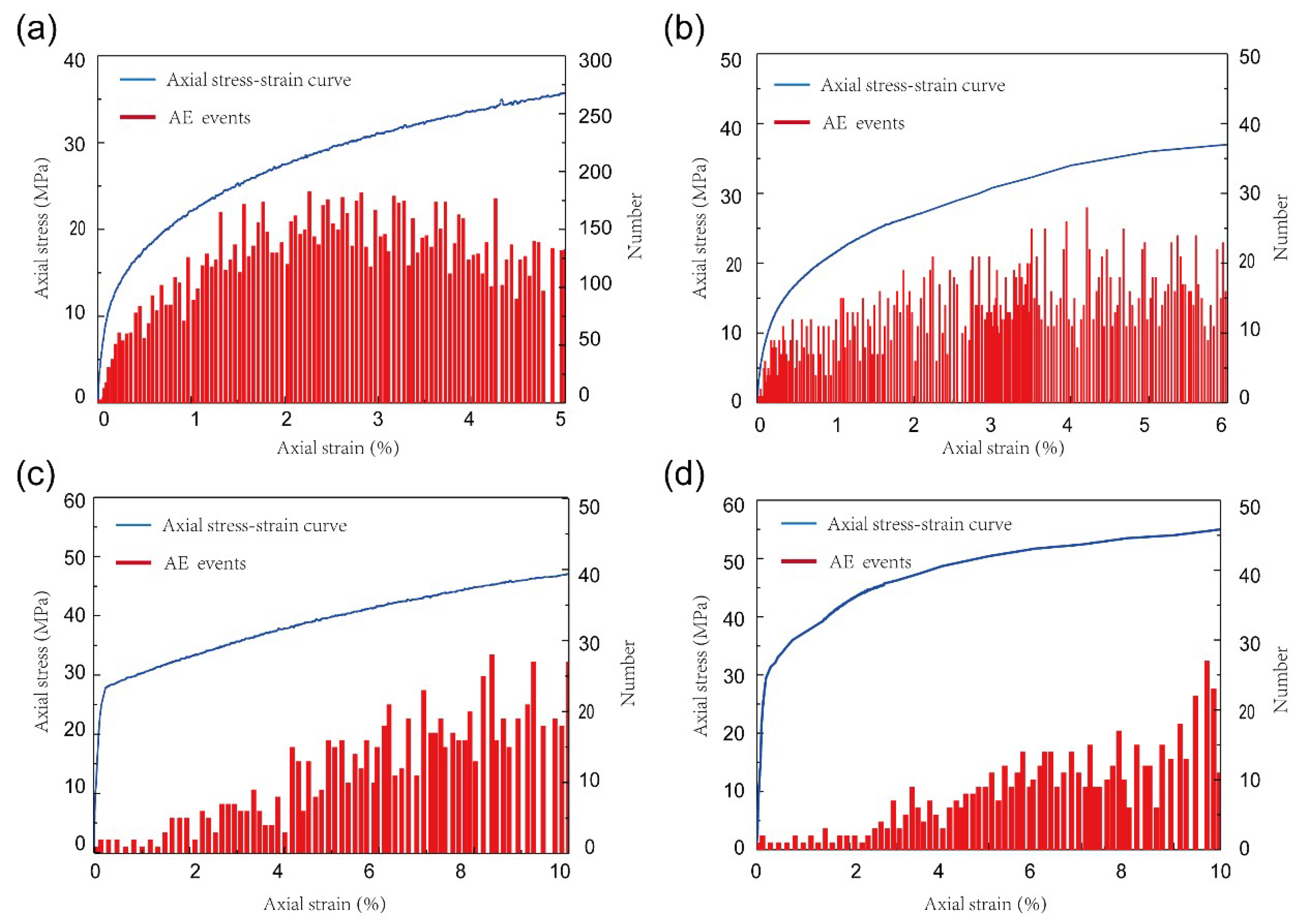

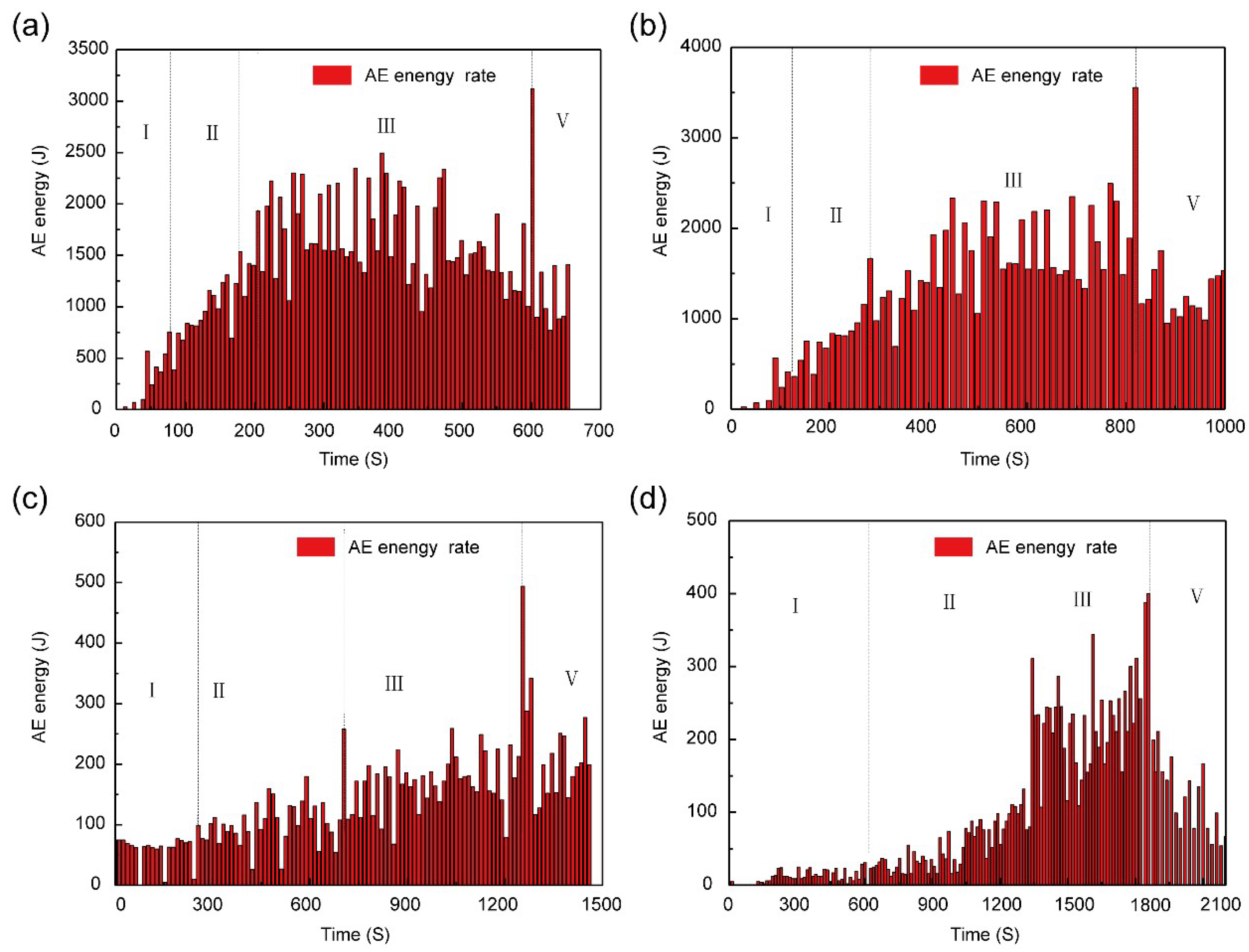
| Critical Strength/MPa | Confining Pressure | |||
|---|---|---|---|---|
| 5 MPa | 10 MPa | 15 MPa | 20 MPa | |
| Crack initiation threshold stress | 10.1 | 12.2 | 13.3 | 14.0 |
| Dilatancy boundary stress | 13.6 | 14.5 | 15.3 | 16.2 |
| Short-term strength | 16.9 | 18.1 | 19.7 | 22.2 |
| Damage ultimate stress | 27.1 | 29.9 | 41.2 | 52.3 |
© 2019 by the authors. Licensee MDPI, Basel, Switzerland. This article is an open access article distributed under the terms and conditions of the Creative Commons Attribution (CC BY) license (http://creativecommons.org/licenses/by/4.0/).
Share and Cite
Li, H.; Dong, Z.; Ouyang, Z.; Liu, B.; Yuan, W.; Yin, H. Experimental Investigation on the Deformability, Ultrasonic Wave Propagation, and Acoustic Emission of Rock Salt Under Triaxial Compression. Appl. Sci. 2019, 9, 635. https://doi.org/10.3390/app9040635
Li H, Dong Z, Ouyang Z, Liu B, Yuan W, Yin H. Experimental Investigation on the Deformability, Ultrasonic Wave Propagation, and Acoustic Emission of Rock Salt Under Triaxial Compression. Applied Sciences. 2019; 9(4):635. https://doi.org/10.3390/app9040635
Chicago/Turabian StyleLi, Haoran, Zhikai Dong, Zuolin Ouyang, Bo Liu, Wei Yuan, and Hongwu Yin. 2019. "Experimental Investigation on the Deformability, Ultrasonic Wave Propagation, and Acoustic Emission of Rock Salt Under Triaxial Compression" Applied Sciences 9, no. 4: 635. https://doi.org/10.3390/app9040635
APA StyleLi, H., Dong, Z., Ouyang, Z., Liu, B., Yuan, W., & Yin, H. (2019). Experimental Investigation on the Deformability, Ultrasonic Wave Propagation, and Acoustic Emission of Rock Salt Under Triaxial Compression. Applied Sciences, 9(4), 635. https://doi.org/10.3390/app9040635




